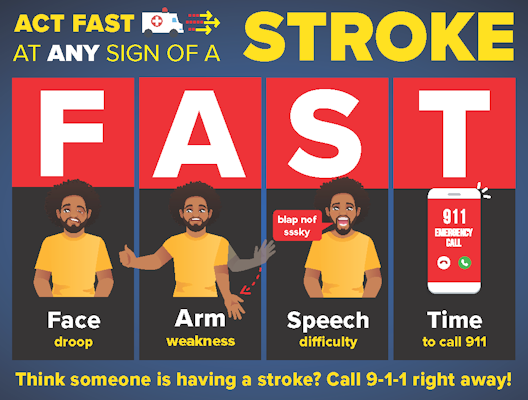Stroke
Think someone is having a stroke? Call 9-1-1 right away!
Treatment needs to be given FAST. It can lower a person's risk of dying.

A stroke is an emergency. It's sometimes called a brain attack.
The brain starts to die because it is not getting oxygen.
What is a Stroke?
A stroke happens when oxygen-carrying blood is blocked from reaching the brain. Brain cells begin to die. All strokes are sudden.
There are 3 types of stroke. Each type blocks oxygen from reaching the brain differently.
- Ischemic (is-skeem-ic): A blood clot blocks a blood vessel in the brain. The American Stroke Association says 87% of all strokes are ischemic.
- Hemorrhagic (hem-or-ah-jick): A blood vessel bursts and leaks blood into the brain.
- Transient Ischemic Attacks, TIAs: "Mini strokes" Symptoms last for a short time. TIAs are still a medical emergency. They are also a warning sign of a future stroke.
Strokes can be treated but every minute counts. Call 9-1-1 at the first sign of a stroke. In 2015, stroke was the fifth leading cause of death in New York State. Strokes are also a cause of major disability.
Signs and Symptoms of Stroke
All major stroke symptoms appear suddenly, without warning. You may not know you're having a stroke because a stroke damages the brain. Someone near you may notice and should call 9-1-1 right away. A stroke does not often cause pain. It should still be taken seriously and taken care of at once!
"FAST" can help you recall stroke's most common signs and symptoms.
- F = Face: Ask the person to smile. Does one side of their face droop?
- A = Arm: Can the person raise both arms? Does one arm drift down? Is their arm weak?
- S = Speech: Ask the person to repeat a simple phrase. Is their speech slurred or confusing?
- T = Time: Time is critical. Very important: Note the time when stroke symptoms first appear. Call 9-1-1 right away. Anyone who may be having a stroke should let an ambulance drive them to the hospital.
Do you have any of these symptoms? Does someone near you? Call 9-1-1 now!
More Signs of a Stroke. They all Happen Suddenly:
- Numb or weak face, arm, or leg. Mostly on one side.
- Trouble seeing with one or both eyes.
- Trouble speaking.
- Confusion or trouble understanding other people.
- Dizziness.
- Loss of balance or coordination, or trouble walking.
- Severe headache – comes on for no reason.
Are You at Risk?
Strokes can be prevented. You can reduce your risk of having one. Talk to your health care provider about:
- High Blood Pressure, or Hypertension. This raises the risk for stroke more than anything else. Ask how you can lower your blood pressure.
- High Cholesterol. Work with your health care provider to manage and control your cholesterol.
- Smoking. Avoid smoking or quit. Work with your health care provider to successfully quit smoking.
- Obesity. Eat in a healthy way and get regular physical activity.
- Diabetes. Work with your health care provider to manage and control your diabetes.
Treatment
After you call 9-1-1, treatment will start right away. An Emergency Medical Services (EMS) provider will arrive and begin treatment on the way to the hospital. An EMS provider's job is to help patients survive and recover.
EMS providers are a critical part of the stroke team. They receive special training to quickly identify strokes. They take patients to the nearest hospital or stroke center. EMS first calls ahead to allow hospitals to prepare. This way the hospital can treat stroke patients as fast as possible.
The New York State Health Department oversees more than 100 stroke centers. They make sure the centers are highly trained to identify and treat stroke patients.
Common Treatments
A time-sensitive medicine called t-PA can dissolve a blood clot. A health care provider may give this medicine soon after stroke symptoms appear. It allows blood and oxygen to flow to the brain. The sooner t-PA is given, the better. It will raise the patient's chances for a full recovery.
Another way to treat a stroke is to remove the blood clot. This should be done soon after stroke symptoms appear. A "catheter" or thin tube is put in an artery in the patient's leg or arm. The tube travels to the brain. Then, a "stent" or wire cage grabs the clot and removes it.
Yet another way to treat a stroke is to send the catheter to the source of the bleeding. It then drops an item like a "coil," or tiny spirals of wire, at that spot. In some cases, this prevents the blood vessel from breaking again.